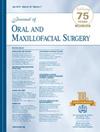Is Treatment at a Level 1 Trauma Center Associated With Better Outcomes Among Patients With Isolated Mandible Fractures?
IF 2.3
3区 医学
Q2 DENTISTRY, ORAL SURGERY & MEDICINE
引用次数: 0
Abstract
Background
The trauma literature suggests that treatment at a level 1 trauma center is associated with improved outcomes for a diversity of injuries. However, differences in outcomes with respect to trauma center designation are poorly studied in the facial trauma demographic.
Purpose
The purpose of this study was to measure the association between trauma center designation and clinical outcomes in patients undergoing management of isolated mandible fractures.
Study Design, Setting, Sample
This was a retrospective cohort study using the 2018 to 2022 American College of Surgeons National Trauma Data Bank. Adult patients with an isolated mandibular fracture undergoing open reduction internal fixation or closed reduction were included. Patients missing demographic or outcomes data were excluded.
Predictor/Exposure/Independent Variable
The primary predictor was trauma center designation (level 1 or nonlevel 1).
Main Outcome Variable
The primary outcome was any complication. Secondary outcomes were return to the operating room, length of stay, adverse discharge disposition, and specific complications.
Covariates
Covariates were categorized into demographic (age, sex), medical (Elixhauser Comorbidity Index), injury severity, operative intervention (open reduction internal fixation or closed reduction), and hospital characteristics (teaching status, bed size).
Analyses
Descriptive, bivariate, and multiple regression statistics were performed to evaluate the association between trauma center designation and outcomes.
Results
The cohort was composed of 28,897 subjects with a mean age of 35.1 ± 14.0 years, and 23,718 were male (82.1%). There were 16,788 (58.1%) and 12,109 (41.9%) subjects treated at level 1 and nonlevel 1 trauma centers, respectively. Complication rates were 1.10% (188) and 1.00% (120) at level 1 and nonlevel 1 trauma centers, respectively (relative risk: 0.88; 95% confidence interval: 0.70 to 1.11; P = .3). After adjusting for demographic, medical, injury severity, operative intervention, and hospital characteristic covariates, treatment at a level 1 trauma center was not independently associated with complications, nor was it associated with return to the operating room, length of stay, or adverse discharge disposition.
Conclusions and Relevance
Trauma center designation was not an independent predictor of adverse outcomes. Additional studies are needed to identify which patients will benefit most from treatment at a level 1 trauma center in this demographic.
在一级创伤中心治疗孤立性下颌骨骨折患者是否有更好的预后?
背景:创伤文献表明,在1级创伤中心治疗可改善各种损伤的预后。然而,在面部创伤人口统计中,关于创伤中心指定的结果差异的研究很少。目的:本研究的目的是衡量创伤中心的指定与接受孤立性下颌骨骨折治疗的患者的临床结果之间的关系。研究设计、环境、样本:这是一项回顾性队列研究,使用了2018年至2022年美国外科医师学会国家创伤数据库。成人孤立性下颌骨骨折患者接受开放复位内固定或闭合复位。排除了缺少人口统计学或结局数据的患者。预测因素/暴露因素/自变量:主要预测因素是创伤中心指定(1级或非1级)。主要结局变量:主要结局是任何并发症。次要结果为返回手术室、住院时间、不良出院处置和特定并发症。协变量:协变量分为人口学(年龄、性别)、医学(Elixhauser共病指数)、损伤严重程度、手术干预(切开复位内固定或闭合复位)和医院特征(教学状况、床位大小)。分析:采用描述性、双变量和多元回归统计来评估创伤中心名称与结果之间的关系。结果:该队列由28,897名受试者组成,平均年龄为35.1±14.0岁,其中男性23,718人(82.1%)。在一级和非一级创伤中心分别有16,788(58.1%)和12,109(41.9%)名受试者接受治疗。1级和非1级创伤中心的并发症发生率分别为1.10%(188例)和1.00%(120例)(相对危险度:0.88;95%置信区间:0.70 ~ 1.11;p = .3)。在调整了人口统计学、医学、损伤严重程度、手术干预和医院特征协变量后,1级创伤中心的治疗与并发症没有独立关联,也与返回手术室、住院时间或不良出院处置无关。结论和相关性:创伤中心的指定并不是不良结果的独立预测因子。需要进一步的研究来确定在这一人群中,哪些患者将从一级创伤中心的治疗中获益最多。
本文章由计算机程序翻译,如有差异,请以英文原文为准。
求助全文
约1分钟内获得全文
求助全文
来源期刊

Journal of Oral and Maxillofacial Surgery
医学-牙科与口腔外科
CiteScore
4.00
自引率
5.30%
发文量
0
审稿时长
41 days
期刊介绍:
This monthly journal offers comprehensive coverage of new techniques, important developments and innovative ideas in oral and maxillofacial surgery. Practice-applicable articles help develop the methods used to handle dentoalveolar surgery, facial injuries and deformities, TMJ disorders, oral cancer, jaw reconstruction, anesthesia and analgesia. The journal also includes specifics on new instruments and diagnostic equipment and modern therapeutic drugs and devices. Journal of Oral and Maxillofacial Surgery is recommended for first or priority subscription by the Dental Section of the Medical Library Association.
 求助内容:
求助内容: 应助结果提醒方式:
应助结果提醒方式:


